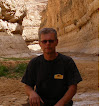Khami was the capital of Shona (Torwa) civilization in the 15-18 century. The ruins of the abandoned city of Khami are located 22 km from Bulawayo. The place is the National Monument since 1937 and the UNESCO World Heritage Site since 1986.

The road taking to the historical site was decently marked starting already from the downtown of Bulawayo. Only the GPS showed the existence of the route only the first 15 kilometers and then the road came to an end for this instrument. A few more kilometers, and then a sign directed to turn right, and further on it was already a sandy cattle path.

I drive on and a sign indicates that there is a school ahead. It is always interesting to see schools, but the road turns away just before the school and there are only cows walking along the road. For a moment it seemed that there is not really anyone here, but the then the road was closed by a barrier, behind that one could see a parking lot and picnic area and as it turned out later, could have spent the night there as well.
The price of the ticket was 10 USD and an-hour- guide - service cost 2 USD.

The path taking to the ruins of the historic city. Thanks to the rainy season everything around is green.

The first walls.


Rounded corners are characteristic to Zimbabwe`s stone buildings.

No binding material is used between the stones, everything stands firm under the influence of its own strength.


Probably this cross was placed by the first Portuguese missionaries.

Gong Rocks - very odd boulders. At first, like a very ordinary Zimbabwean stone pile. But if to take the smallest stone and knock with it against the bigger ones - then - after knocking - one can hear soft and metallic sound coming from inside the boulder. As if someone is ringing the church bell.
The Matobo National Park was founded in 1926, then - named The Rhodes Matopos National Park. The park is located 35 km south of Bulawayo, and is Zimbabwe's first national park, with the area of 425 km2 and it is famous for different sizes of rock formations and cave drawings. Since 2003, the Matobo Hills is World Heritage Site by UNESCO.

The road taking to the cave of Bambata. There is 3 km of roadway and one more kilometer of footpath between rocks and cliffs. The guards were at the beginning of the road and the visitor`s name was written down in a book. The previous visitor had been there two weeks ago.





Bambata Cave

Cave drawings.

A view from the cave

Zimbabwe – Matobo Hills


The grave of Cecil Rhodes is in Matobo National Park.
I do not know how to write briefly about Cecil Rhodes, it is still a long story, but to South Africa, he was just as important as George Washington or Abraham Lincoln to North America. A politician, the founder of the De Beers diamond company, the founder of Rodesia (Rhodesia). In 1980 Rhodesia was named Zimbabwe. Read more about Rhodes in Wikipedia
The grave on the hill, which he himself called "World View", the local Ndebele people call this place Malindidzimu – in English - "Dwelling Place of Benevolent Spirits".


When the weather is fine here we can enjoy, of course, super views, but it is really great that the rain has stopped for a few hours.

Matobo Hills. Sunset in Zimbabwe.
Continued .. Another couple hundred picture of the beautiful rocky and mountainous nature of Zimbabwe could be added here - but the next topic is waiting for its turn. And it will be - the Great Zimbabwe Ruins - because they are the largest stone buildings in Africa outside of Egypt.



No comments:
Post a Comment